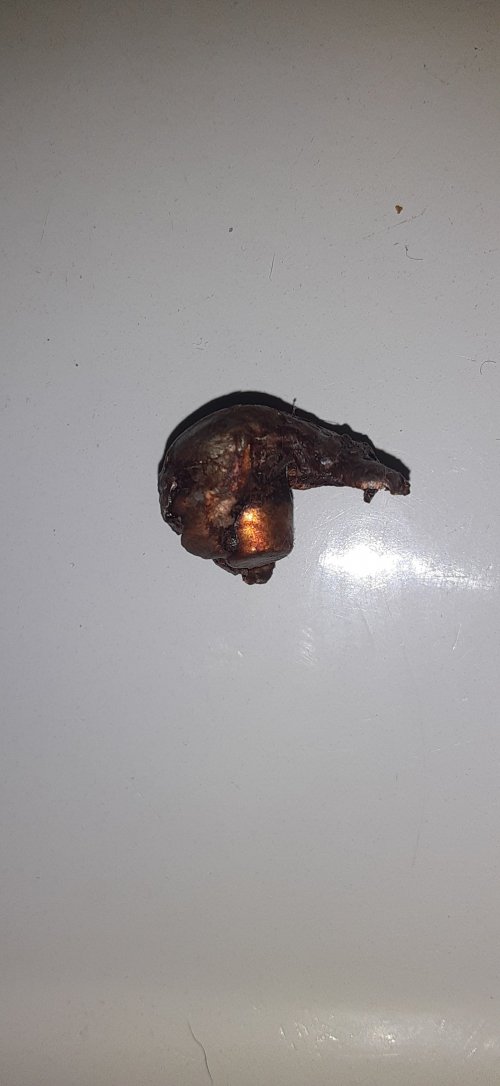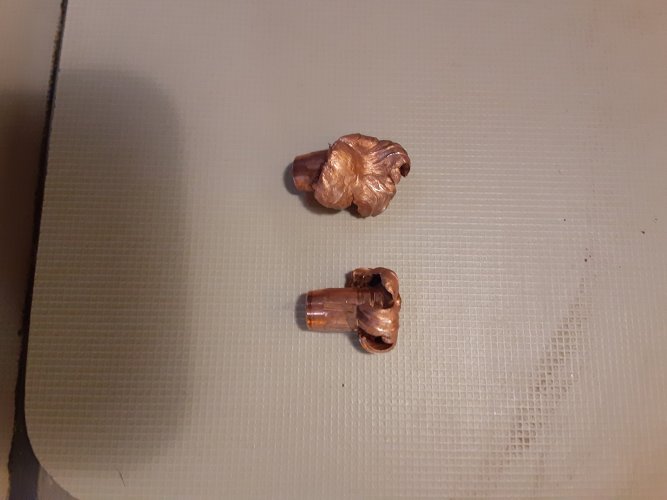MTLabrador
Well-known member
I’ll probably switch to 166 Hammers next year, but the 168 Barnes in .300 Win Mag holds the current record for fastest elk kill that I’ve seen. I’ve never had anything but great performance with them.
Follow along with the video below to see how to install our site as a web app on your home screen.
Note: This feature may not be available in some browsers.

The opposite is true. You need to watch your velocity if you’re shooting them at longer ranges. More velocity means more expansion.I think monos excel at long distances where velocity is trailing off.
It was because I spat out the lead fragment and my chipped tooth (along with all the meat in my mouth) when I felt it, but thanks anyways.If you broke a tooth it wasn’t on a lead fragment.
At longer range the bullet is running out of gas so expansion becomes more "conventional" as magnum muzzle velocity bullet approaches conventional speed. At close range is where unaffected high speed muzzle velocity and more expansion becomes a problem. The advantage to mono at long range is less expansion and more penetration than conventional bullets. Same advantage at close range but a faster pass through might leave the shooter wondering if he actually hit the animal. At long range the mono bullet has slowed down and the thump factor increases. He might reliably get an exit wound at 500 yards with mono but not so much with conventional lead bullet which is designed to expand more on impact as opposed to monos which expand more slowly. A well placed shot should do the job with either bullet but it's not easy making a well placed shot at 500-700 yards for a mere mortal with conventional (i.e. affordable) equipment.The opposite is true. You need to watch your velocity if you’re shooting them at longer ranges. More velocity means more expansion.
At longer range the bullet is running out of gas so expansion becomes more "conventional" as magnum muzzle velocity bullet approaches conventional speed. At close range is where unaffected high speed muzzle velocity and more expansion becomes a problem. The advantage to mono at long range is less expansion and more penetration than conventional bullets. Same advantage at close range but a faster pass through might leave the shooter wondering if he actually hit the animal. At long range the mono bullet has slowed down and the thump factor increases. He might reliably get an exit wound at 500 yards with mono but not so much with conventional lead bullet which is designed to expand more on impact as opposed to monos which expand more slowly. A well placed shot should do the job with either bullet but it's not easy making a well placed shot at 500-700 yards for a mere mortal with conventional (i.e. affordable) equipment.
Foot-pascalsThump factor is a new one to me... what units is that measured in?

You've got to be joking, right... right?At longer range the bullet is running out of gas so expansion becomes more "conventional" as magnum muzzle velocity bullet approaches conventional speed. At close range is where unaffected high speed muzzle velocity and more expansion becomes a problem. The advantage to mono at long range is less expansion and more penetration than conventional bullets. Same advantage at close range but a faster pass through might leave the shooter wondering if he actually hit the animal. At long range the mono bullet has slowed down and the thump factor increases. He might reliably get an exit wound at 500 yards with mono but not so much with conventional lead bullet which is designed to expand more on impact as opposed to monos which expand more slowly. A well placed shot should do the job with either bullet but it's not easy making a well placed shot at 500-700 yards for a mere mortal with conventional (i.e. affordable) equipment.
Back when lead shot was legal an awful lot of goose hunters chomped down on high antimony(hard) lead BBs without cracking teeth. If you cracked a tooth on lead, there’s a pretty good chance that tooth wasn’t particularly healthy was gonna crack pretty soon anyway.It was because I spat out the lead fragment and my chipped tooth (along with all the meat in my mouth) when I felt it, but thanks anyways.
Exactly. At long distance the mono bullet's expansion decreases and consequently potential for penetration increases because the bullet form is tighter. Labrador said the potential for expansion increases at distance and physically that doesn't make sense. The monos can be driven at higher muzzle velocity but at long distance that velocity is obviously diminished to something comparable to a heavier lead bullet at medium range. At the same velocity do the two bullets hold together the same? Not what I am reading. So a bullet that holds together better and retains more velocity will have the advantage of greater penetration on impact at long range. The slight disadvantage would be nominal expansion, compared to close range anyway.All due respect... it is evident your PHD is not in physics.
A strength of mono bullets is that they do not blow up at close range. They expand considerably and penetrate far more than a lead bullet at closer ranges.
A drawback for them is as the velocity drops, the expansion decreases. At some point, the expansion becomes too small for reliable performance.
Thump factor is a new one to me... what units is that measured in?
The reason that the mono bullets run light for their caliber is so that the bullet can be driven at higher velocity. That gives the bullet both a flatter trajectory and a greater effective range.
Exactly. As stated above, at close range I saw my brother shoot a buck through the boiler room with 300 Win mono and we both thought he missed. No audible impact and the buck didn't act like it was hit. Sometimes, as in the case of oversize buffalo or long range shooting (which I don't encourage), sufficient tissue damage requires sufficient penetration. A bullet that comes apart easily will penetrate less. You're right, it's a balancing act. Ideally the shooter should carry close range ammo and long range stuff if he wants to play both games. In open country my 30-06 is loaded with 165 gr but I have some 190 gr handy when I'm tracking in timber. In the past I tried 165 gr Barnes mono but they didn't pattern real great for whatever reason so I gave up on them. Shot a very large muley buck with one on the run at 75 yards. He fell in his tracks with bullet hitting him at base of neck and ahead of the shoulder. The butcher said there was a lot of damage but who knows. At that spot I doubt it. He may have been looking for a tip.You've got to be joking, right... right?
A pass through is not what kills an animal. Tissue damage is what kills an animal. A bullet that doesn't disrupt and expand is less likely to kill an animal quickly. Monos are not "better" than properly chosen traditional bullets at most ranges or velocities. There is usually a jacketed lead core bullet that will perform better (i.e.) more destructive to tissue, while retaining penetration, at a given impact velocity than pure copper. Even on short shots! Copper just happens to be less toxic to humans, and it will perform reasonably well at low impact velocities, while not completely melting down at insane impact speeds. It's a balanced choice, but it is far less destructive at lower impact velocity than some of the thin jacketed match bullets.
Damn evolving language!That is one usage of the many in modern language listed by Webster, but lithic really does refer to stone. I am sure you can Google some other usages. I am certain that nobody really cares if words used in our modern version of English hold their traditional meaning. I would bet that even "monometal' misses the mark. Webster has added many words such as "ain't" and some modern usages of "cool" also.
It does indeed pay to be correct, but generally it does not pay enough to be worth the effort. I should have kept quiet.
I wish I would have taken a picture of it, but alas I was just mad in the moment and threw it away. I know the unlikelihood of breaking a tooth on a lead fragment, but it's what happened and that's a reason I switched to bullets that I know hold their mass together, like GMX and TTSX. Hornady just released their CX in place of the GMX so I'm sure I'll use that too.Back when lead shot was legal an awful lot of goose hunters chomped down on high antimony(hard) lead BBs without cracking teeth. If you cracked a tooth on lead, there’s a pretty good chance that tooth wasn’t particularly healthy was gonna crack pretty soon anyway.
A lot of those copper monos are also meant to fragment, and if you chomp down on a copper petal you’re going to be in a lot worse shape than chomping down on a lead fragment.
There are plenty of good reasons for people to choose lead cored or copper bullets over the other, but I’m fairly sure that the danger of breaking teeth on fragments from either type should be very low on that list of reasons.
This is a good reason to process your own meat if you can, and to do so carefully. I have found a few bullet fragments in areas with no bruising, bloodshot meat, or other obvious signs of a wound, but that’s pretty unusual. I cut well around bloodshot, bruised or otherwise wounded meat when I butcher. I can’t say that I ever remember having found a bullet fragment in a piece of meat that I’ve cooked. I have found pellets in birds that were on my plate in spite of taking similar care. Steel shot is a DEFINITE tooth hazard.